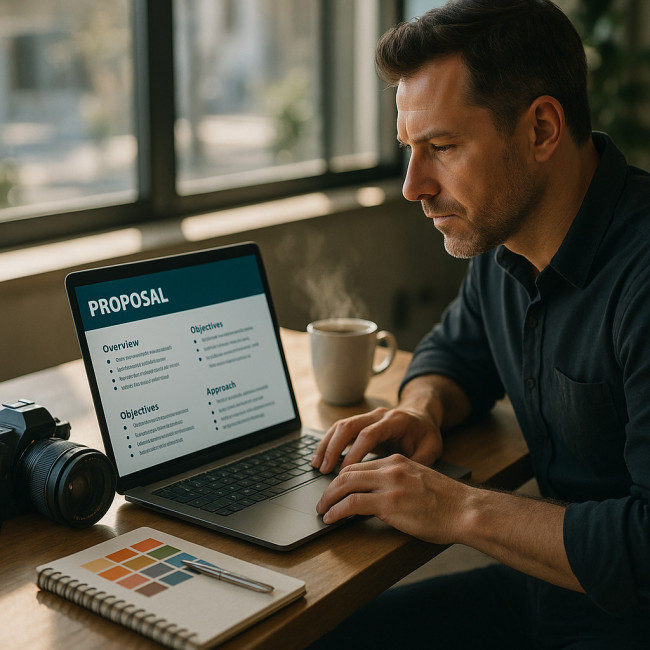Pitching event organisers: craft proposals that get your photography on stage
You have the talent, but securing a prime spot on the event calendar depends on one thing: a proposal that makes organisers say “We need this photographer”. Follow this guide to craft persuasive offers, win decision-makers' trust and turn enquiries into booked gigs—fast.
Why a tailored proposal beats a generic portfolio every time
Event organisers juggle tight schedules, multiple suppliers and risk-averse stakeholders. They need more than beautiful images; they need proof that you understand logistics, audience experience and return on investment (ROI). A sharply focused proposal shows:
- Relevance – you align visuals with the event's theme, sponsors and audience.
- Reliability – clear timelines and backup plans reduce organiser stress.
- Revenue impact – data-backed examples demonstrate how your images drive ticket sales, media coverage or sponsor renewals.
The five-part framework for an irresistible pitch
1. Lead with a laser-sharp value statement
Open with one sentence that answers the organiser's biggest question: “What do we gain?” Example: “High-energy, brand-aligned photo sets delivered within 12 hours to fuel real-time social promotion and post-event sponsorship reports.”
2. Mirror the event's goals with visual mood boards
Attach a mini mood board of 6–8 images annotated with captions such as “Wide crowd shot for press release” or “Sponsor logo hero angle”. Pair it with a link to your optimised directory profile so organisers can deep-dive without hunting.
3. Detail deliverables, timelines and contingency plans
- Shoot schedule – list call times, location moves and battery swap breaks.
- Editing workflow – outline same-day selects versus full gallery delivery dates.
- Backup strategy – dual-card capture, on-site SSD clone, cloud upload in 24 h.
- Weather or technical contingencies – spare bodies, lenses and an agreement for rescheduled portrait sessions if storms hit.
4. Build trust with transparent pricing and ROI
Organisers fear hidden fees. Provide a clear package comparison (see table) and include one line showing potential value, e.g. “A single viral image series lifted XYZ Festival ticket sales by 18 % in 2023.” Where possible, link to public proof or media clippings.
| Package | Hours on site | Deliverables | Typical fee (€) | Ideal for |
|---|---|---|---|---|
| Highlight Sprint | 2 | 25 edited images, 4 h turnaround | 650 | Press launches |
| Full-Day Story | 8 | 120 edited images, next-day gallery | 1 850 | Conferences |
| Hybrid Gold | 10 + live upload | 150 images, 10 social-ready clips | 2 400 | Festivals & branded events |
5. Add social proof that resonates
Feature organiser-specific proof: testimonial quotes, press snippets or metrics like “2 M organic impressions within 48 h”. Place these on a shaded sidebar so they jump off the page.
Formatting tricks that keep busy organisers reading

Every design choice you make—font pairing, whitespace ratio, bullet indentation, even hyperlink colour—either invites an overworked organiser to linger or pushes them toward the next supplier in their inbox. Imagine their reality: they are scanning proposals on a smartphone during a cab ride between venue inspections, juggling Slack pings from sponsors and last-minute stage-layout PDFs. If your document loads quickly, displays in a single, scroll-friendly column and surfaces the core benefits in under eight seconds, you instantly earn more cognitive bandwidth than competitors who bury pricing behind dense paragraphs. Use no more than three colour accents, apply consistent heading levels and embed tappable links that open in-app rather than launching new browser tabs. These seemingly small UX tweaks compound, making your proposal feel like a friction-free extension of the organiser's own workflow and signalling that you will handle their imagery with the same clarity and precision.
- One-page core, plus annexes for detailed tech specs and licensing terms.
- Bullet summaries every 200 words to aid skim readers.
- Readable typography: 12–14 pt, high-contrast colours and sub-headings under 55 characters.
- Interactive links to your event-specialist photographer portfolio, behind-the-scenes reels and booking calendar.
Send, follow up and negotiate like a pro
- Timing: Email the proposal within 24 h of the discovery call while enthusiasm is high.
- Subject line: “Proposal – Live social coverage & photo story for [Event Name]”.
- Follow-up cadence: Day 3 quick reminder, Day 7 value add (e.g. case study link), Day 14 optional call.
- Negotiation pivot: If budget cuts arise, reduce deliverables, never your day rate.
- Seal the deal: Offer digital contract signing and staged invoices—50 % deposit, 30 % event day, 20 % on final gallery.
Common proposal mistakes—and how to avoid them
- Sending generic PDFs without referencing the organiser's brand colours or messaging.
- Ignoring licensing clarity; always specify usage period, media and territory.
- Overloading with jargon—replace “ambient key-light ratio” with “soft flattering portraits”.
- Skipping a contingency clause; organisers crave risk mitigation.
- Failing to include next steps—add a bold “Approve & schedule pre-event walk-through” button or link.
Tools and resources to sharpen your competitive edge
Streamline your pitching workflow using:
- A proposal template app like Better Proposals or Bonsai.
- Real-time booking widgets—sync with your Live Availability Calendar (learn how to set one up).
- Retainer models for recurring events—see how retainers stabilise income.
- Event-scouting platforms listing call-for-photographers—plan ahead with this 2025 event calendar.
Quiz: How proposal-ready are you?
FAQ
- How far in advance should I pitch for large festivals?
- Four to six months ahead. Major events lock suppliers early and require time for accreditation and floor-plan walk-throughs.
- What file formats do organisers prefer for fast social sharing?
- JPEGs under 2 MB, 3000 px longest edge, sRGB colour space. Include a parallel folder of 1080 × 1350 px crops for Instagram / LinkedIn.
- Should I offer raw files?
- Only when explicitly requested and priced accordingly. Provide a separate licence clause and a 20–30 % fee lift to cover lost exclusivity.
- How do I handle image rights when sponsors are involved?
- Insert a tri-party licence stating use for organiser, venue and named sponsors; set a 24–36-month term to protect future resale value.
- What insurance do organisers expect?
- Public liability (min. €2 M), professional indemnity and equipment cover. List certificate numbers in your proposal annex.
Take action now
Download your one-page proposal template, adapt the five-part framework above and book your next event before another photographer does. Your stage is waiting.











